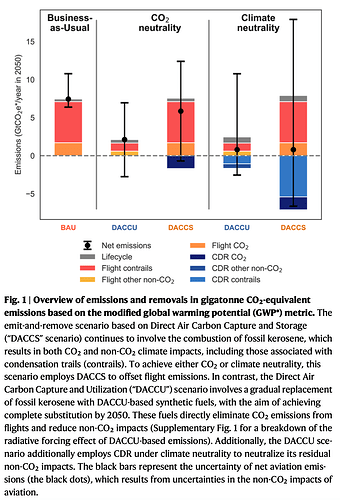The role of direct air capture in achieving climate-neutral aviation
This week, we take a deeper dive into the paper recently published in Nature Communications, lead by Nicoletta Brazzola from the Institute for Environmental Decisions of ETH Zurich, in Switzerland.
The aviation sector has historically contributed to approximately 4% of anthropogenic climate warming and its contribution is expected to grow further in the future, due to increasing air travel demand and limited scalable solutions, posing significant challenges to mitigation objectives. In this context, Direct Air Capture (DAC) technologies might gain relevance, also thanks to the versatility of their applications in this sector, including both atmospheric CO2 removal and storage and synthetic fuels production, which makes their potential in mitigating aviation-related greenhouse gas emissions significant. The study assesses the feasibility and cost-effectiveness of these approaches, considering factors such as energy requirements, scalability, and economic implications.
The authors develop various scenario models to evaluate different potential outcomes based on DAC deployment levels, technological advancements, and associated costs. They also run a techno-economic analysis to assess the economic viability of DAC, comparing the costs of DAC systems, fuel production, and carbon storage with other decarbonization strategies. The researchers examined the energy requirements and efficiency of DAC systems, analyzing their impact on aviation’s overall energy demand and comparing them with alternative technologies. Sensitivity tests are used to explore how variations in key factors such as carbon prices and technological advancements could influence the role of DAC. Abstracting from the most likely yet complex scenario in which a portfolio of technologies is implemented, this study exclusively focuses on the role of DAC in achieving CO2 and climate neutrality in the global aviation sector by 2050.
The analysis includes two different 2050 goals for the aviation sector: CO2 neutrality, implying a reduction of CO2 emissions to net-zero by 2050; and climate neutrality, which also includes non-CO2 effects, allowing for a more balanced comparison of DACCS vs. DACCU technology pathways. Figure 1 compares a business-as-usual scenario with fossil kerosene to different pathways via DAC, showing the breakdown in terms of flight emissions, indirect emissions, and removals. Authors find that the specific climate target determines which option is cheaper. For example, for CO2 neutrality, the DACCS pathway is significantly less costly than the DACCU pathway, which it outperforms by about €0.3 l-1 in 2050 (Figure 2) as DACCU is subject to a considerable cost penalty due to the high electricity and capital costs of electrolysis essential for synthetic fuel production.
Here is a list of the main takeaways from this paper:
- DAC could play a significant role in achieving climate-neutral aviation by providing sustainable synthetic fuels or permanently removing CO₂ from the atmosphere.
- The current high energy requirements and costs of DAC technologies present major challenges to their widespread adoption within the aviation industry.
- While DAC technologies show promise, their economic feasibility depends on overcoming high operational costs and achieving cost parity with alternative decarbonization methods.
- Strong policy frameworks, such as carbon pricing and government incentives, will be essential for scaling DAC technologies and supporting their integration into aviation.
- Significant investments in research, development, and infrastructure are required to advance DAC technologies, improve efficiency, and increase their competitiveness.
Read the full paper here: The role of direct air capture in achieving climate-neutral aviation

